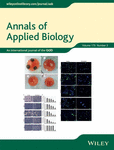Ver ítem
- xmlui.general.dspace_homeCentros Regionales y EEAsCentro Regional Salta - JujuyEEA SaltaArtículos científicosxmlui.ArtifactBrowser.ItemViewer.trail
- Inicio
- Centros Regionales y EEAs
- Centro Regional Salta - Jujuy
- EEA Salta
- Artículos científicos
- Ver ítem
Effect of long-term mineral fertilisation on soil microbial abundance, community structure and diversity in a Typic Hapludoll under intensive farming systems
Resumen
Fertiliser application can not only influence plant communities, but also the soil microbial
community dynamics, and consequently soil quality. Specifically, mineral fertilisation can
directly or indirectly affect soil chemical properties, microbial abundance and, the structure
and diversity of soil microbial communities. We investigated the impact of six different
mineral fertiliser regimes in a maize/soybean rotation system: control (CK,
without
[ver mas...]
Fertiliser application can not only influence plant communities, but also the soil microbial
community dynamics, and consequently soil quality. Specifically, mineral fertilisation can
directly or indirectly affect soil chemical properties, microbial abundance and, the structure
and diversity of soil microbial communities. We investigated the impact of six different
mineral fertiliser regimes in a maize/soybean rotation system: control (CK,
without fertilisation), PS (application of phosphorus plus sulphur), NS (application of
nitrogen plus S), NP (application of N plus P), NPS (application of N, P plus S) and NPSm
(application of N, P, S plus micronutrients). Soil samples were collected at the physiological
maturity stage of maize and soybean in March of 2013 and 2014, respectively. Overall,
mineral fertilisation resulted in significantly decreased soil pH and increased total
organic carbon compared with the control (CK). The analysis of terminal restriction fragment
length polymorphism (T-RFLP) revealed that mineral fertilisers caused a shift in
the composition of both bacterial and fungal communities. In 2013, the highest value of
Shannon diversity of bacterial terminal restriction fragments (TRFs) was found in control
soils. In 2014, NPSm treated soils showed the lowest values of diversity for both bacterial
and fungal TRFs. In both crop growing seasons, the analysis of phospholipid fatty
acid (PLFA) detected the lowest value of total microbial biomass under CK. As PLFA
analysis can be used to evaluate total microbial community, this result suggests that
fertilisation increased total microbial biomass. When the bacterial and fungal abundance
were examined using real time polymerase chain reaction, the results revealed that mineral
fertilisation led to decreased bacterial abundance (16S rRNA), while fungal abundance
(18S rRNA) was found to be increased in both crop growing seasons. Our results
show that mineral fertiliser application has a significant impact on soil properties, bacterial
and fungal abundance and microbial diversity. However, further studies are needed
to better understand the mechanisms involved in the changes to microbial communities
as a consequence of mineral fertilisation.
[Cerrar]

Autor
Verdenelli, Romina Aylen;
Dominchin, Maria Florencia;
Perez Brandan, Carolina;
Rovea, Adrián;
Vargas Gil, Silvina;
Meriles, Jose Manuel;
Fuente
Annals of applied biology (03 September 2019)
Fecha
2019-09-03
Editorial
Wiley
ISSN
1744-7348
Formato
pdf
Tipo de documento
artículo
Palabras Claves
Derechos de acceso
Restringido
 Excepto donde se diga explicitamente, este item se publica bajo la siguiente descripción: Creative Commons Attribution-NonCommercial-ShareAlike 2.5 Unported (CC BY-NC-SA 2.5)
Excepto donde se diga explicitamente, este item se publica bajo la siguiente descripción: Creative Commons Attribution-NonCommercial-ShareAlike 2.5 Unported (CC BY-NC-SA 2.5)

